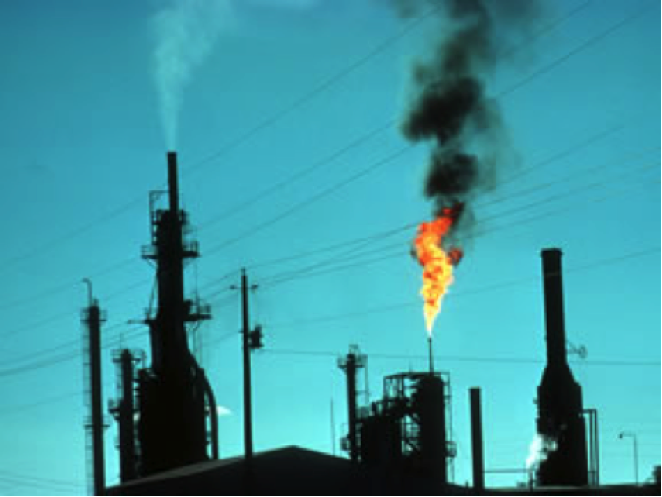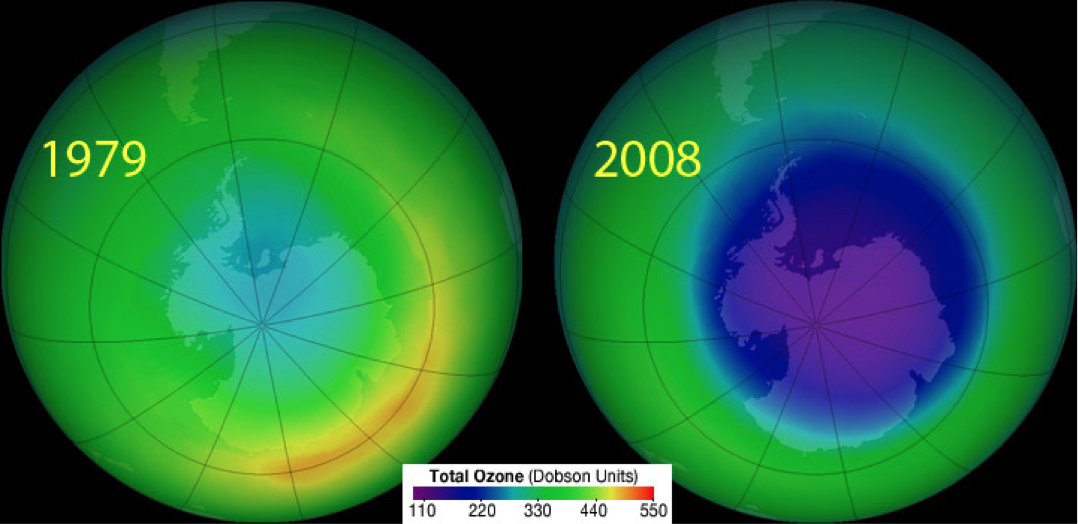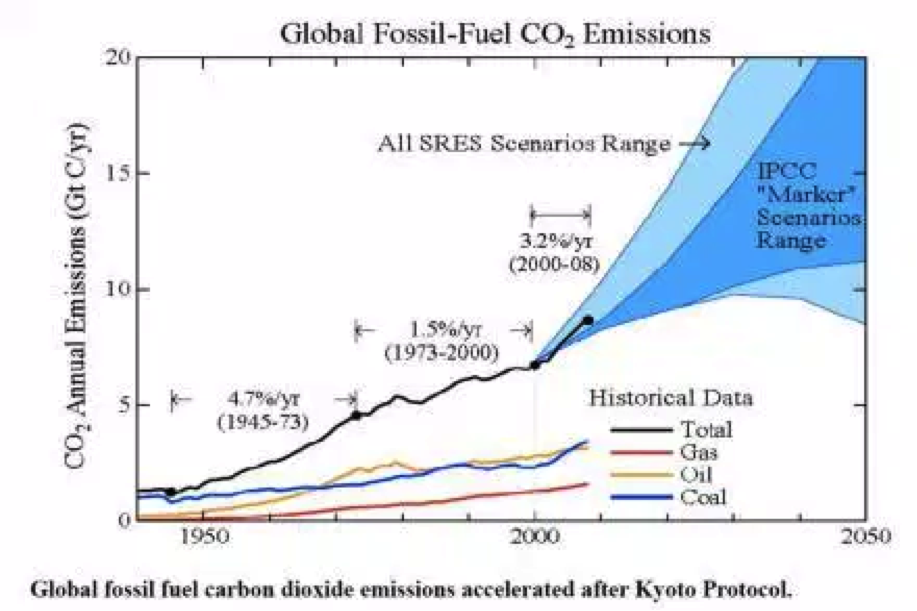|
Factories all around the world are huge contributors to emission of greenhouse gasses. http://www.windows2universe.org/earth/Atmosphere/pollution_climate_change.html Air Pollution and Climate Change: Causes and Effects Over the last few decades, environmental issues have been growing and, although these issues may be frequently discussed, too little has been done to change the lasting effects humans are causing on our planet. Most notably are the issues of global warming and air pollution. Global warming is caused by the release of greenhouse gases into the atmosphere. These greenhouse gases trap the heat from the sun, which helps to warm the planet. One greenhouse gas is CO2, which comes from both car and truck exhaust and burning fossil fuels for energy. With the increase of carbon dioxide and other air pollutants released from factories over the last 150-200 years, these gases are responsible for the majority of global warming that has occurred (Gardiner, 2008). Although there are some air pollutants (aerosols) that lower the temperature of the earth, greenhouse gases stay in the atmosphere for much longer (CO2 can last 5-200 years) and heat at least two times more than aerosols cool (Clowney and Motso, 351; Gardiner, 2008). Global warming has become such a large issue because countries are not working together to decrease their pollution levels. These issues can either been seen as global issues that require the world to work together or as regional problems that each area must handle themselves. The Kyoto Protocol was one attempt to handle greenhouse gas emission on a global level. Although around 126 countries have ratified it, the U.S.A, who releases the most carbon, has not yet agreed to this protocol. Also, as of 2008 other huge carbon releasing countries such as India and China are not required to change their emission levels (Clowney and Motso, 326). These nations are huge contributors to the rising pollutant levels in the atmosphere and with their reluctance to cut back nothing will have the opportunity to be improved. It is very daunting to approach these issues in a global manner, but without the compliance of the whole world the pollution will continue to increase and the temperature of the earth will surely rise. Already global warming has been occurring at a much faster rate than was ever anticipated and it has been stated with more than 90% certainty that human activity is behind all the warming (Clowney and Motso, 329). It seems that we have not acted fast enough to stop our ways because we are already guaranteed to raise the temperature of the earth by two degrees, but if we do not change our industrial ways then our planet will rise by four more degrees, which will have drastic effects in all areas of the world (Clowney and Motso, 329). Humans are and will continue to be affected by the changes in our climate in addition to plants and animals. The ozone is another very important aspect of the atmosphere that is being affected and its depletion is greatly affecting the human population. The ozone layer helps keep in heat from the sun, but it also helps to protect us from the sun’s harmful ultraviolet rays. However, a hole has been created in the ozone due to the many damaging chemicals used by humans (Clowney and Motso, 332). The thinning of the ozone layer allows more UV light to pass through the earth’s atmosphere. Human exposure to an excessive amount of solar radiation and ultraviolet rays can lead to different skin cancers, including cutaneous melanoma. Those with pale skin and people who spend excessive time in the sun are more even more susceptible to skin damage and skin cancer. The hole in the ozone layer in 1979 compared to 2008. http://www.windows2universe.org/earth/Atmosphere/ozone_hole.html Other health related issues are especially high for people in areas with high amounts of CO2. The young, elderly, and those with respiratory issues are at a higher risk of survival in areas with large amounts of CO2 ("Air Pollution: Current and Future Challenges."). Individuals who live in the city will face these problems more than those who live in the country. People of lower classes and those who live in third world countries are even more vulnerable to climate change due to how much they rely on land and natural resources. They cannot afford to have the land destroyed. Instead of helping, our actions now are only going to make matters worse for generations to come. In addition to human harm, animals are also being affected by changes humans are causing in the environment. For example, acid rain is becoming more common as pollution increases. Acid rain has played a huge part in the melting of polar ice caps and warming the oceans. Its acidity has lead to damaged lakes, rivers, and forests, which has greatly affected the environment animals and plants live in (Clowney and Motso, 327). This issue of climate change is most certainly a global issue, but there are many things that can be handled at a more regional level. Although our way of living may be changed some, it is necessary for us to reduce our release of greenhouse gases by finding alternative energy sources that are not carbon based. Additionally, energy use must be limited and conserved. Locally in Lutherstadt Wittenberg, Germany, this town has been doing their part to create more environmentally friendly energy resources- specifically with the water provided through the company Stadtwerke. This plant treats wastewater and purifies it through three different levels of cleaning and ultimately helps to produce energy for the town. First, the wastewater goes through a rake where large materials are sorted out. Sand and suspended minerals are then sorted out after the water flows through a type of chamber (class notes). In the second stage of purification the water goes through biological purification. Microorganisms help to convert pollutants into carbon dioxide, water, and nitrogen. The microorganisms also produce sludge, which is separated from the water. The sludge is extremely important in this process because it is converted into biogas, which is then used as thermal and electrical energy. Through this anaerobic sludge stabilization, 33% of the energy demand in the area is met (class notes). Additionally, at the end of the process the water is clean, crystal clear, and is released into the nearby Elbe River. When asked if there are any negative effects of how this company handles their water and creates energy, a staff member replied, “Everything is good when you make energy from waste.” This small town is helping the world by using alternative ways to make energy, while also cleaning and purifying water. In the future they hope to be able to produce even more energy through these beneficial ways. Sludge before water purification is complete at Stadtwerke. Lutherstadt Wittenberg, Germany Ethical Discussion When discussing the topic of climate change, not much can be said without bringing up ethics. If ethics was not involved in the climate change, would global warming and air pollution even be a problem? In Stephen M. Gardiner’s article A Perfect Moral Storm: Climate Change, Intergenerational Ethics and the Problem of Moral Corruption, he says that, “The peculiar features of the climate change problem pose substantial obstacle to our ability to make the hard choices necessary to address it. Climate change is a perfect moral storm” (Clowney and Mosto, 348). A perfect storm can be defined as individual destructive factors that come together to cause negative outcomes. Gardiner came up with three “storms” that merge to cause the perfect storm for climate change. The first storm is “The Global Storm”. This storm is made up of three important characteristics: dispersion of causes and effects, fragmentation of agency and institutional inadequacy. Dispersion of causes and effects is seen through the release of greenhouse gases into the atmosphere. These effects are not only seen at the source of emission, but are seen globally as well due to the ability of CO2 to last in the upper atmosphere for hundreds of years. Fragmentation of agency is a problem because it is not just one source that is causing climate change. Without having a world government, it is hard to come up with a way to respond to global climate change. Companies get into paradoxical positions because on one hand they know that the right thing to do is for everyone to cooperate, but on the other they know that it is unlikely to happen and they need to keep doing what they are doing for their own economic benefit (Clowney and Mosto, 328). Lastly there is institutional inadequacy. This is a problem because the lack of global government makes it hard to have global regulations for greenhouse gases that we need. Increase in CO2 emissions through 2008 and projected CO2 emissions by IPCC through 2050.
http://bravenewclimate.com/2011/07/13/climate-change-update-by-numbers/ The second storm is “The Intergenerational Storm”. Like the first storm, this storm also made up of the same three characteristics. The phenomenon that climate change caused by humans is part of the first characteristic dispersion of causes and effects. It is said to be a phenomenon because of how long it takes for the effects of greenhouse gases to happen compared to when the gases were actually released into the atmosphere (Clowney and Mosto, 351). There is a huge lag time. Fragmentation of agency and institutional inadequacy both think about future generations and how the actions of today’s people will affect the lives of people in the future. The last storm is “The Theoretical Storm." This storm pertains to the fact that we do not have what is needed to deal with the problems of the long-term future. Gardiner says, “Even our best theories face basic and often severe difficulties addressing basic issues” (Clowney and Mosto, 355). With the convergence of these three storms, Gardiner believes moral corruption is created. This allows for people to be more manipulative and makes them focus on some of the issues instead of all of them. Therefore, in order to better the future for ourselves and for others we have to avoid overtly selfish behavior. Our actions have already proven to be detrimental to ourselves and the rest of our planet. If we continue as we are now, the earth will continue to have increased pollution levels and rising heat. We must take the necessary actions of conserving energy and reducing pollution in order to spare ourselves and future generations and reduce/ reverse the damage we have already done. Literature Cited “Air Pollution: Current and Future Challenges." EPA. Environmental Protection Agency, n.d. Web. 15 Feb. 2016. Class Notes. Science in the Social Context. Wittenberg University, 2016. Clowney, David, and Patricia Mosto, eds. Earthcare: An Anthology in Environmental Ethics. Lanham: Rowman & Littlefield Publishers, 2009. Print. Gardiner, Lisa. “Air Pollution and Climate Change.” Windows to the Universe. 17 June 2008.Web. 15 February 2016. Images http://www.windows2universe.org/earth/Atmosphere/pollution_climate_change.html http://www.windows2universe.org/earth/Atmosphere/ozone_hole.html http://bravenewclimate.com/2011/07/13/climate-change-update-by-numbers/
0 Comments
Leave a Reply. |
AuthorI'm a philosopher, a writer, a thinker, an Inside-Out Prison Exchange Instructor. I do a lot of these on the road as part of recognizing the value of philosophy as a public practice. Archives
October 2018
Categories |
Wittenberg
|
Buy Now |




 RSS Feed
RSS Feed